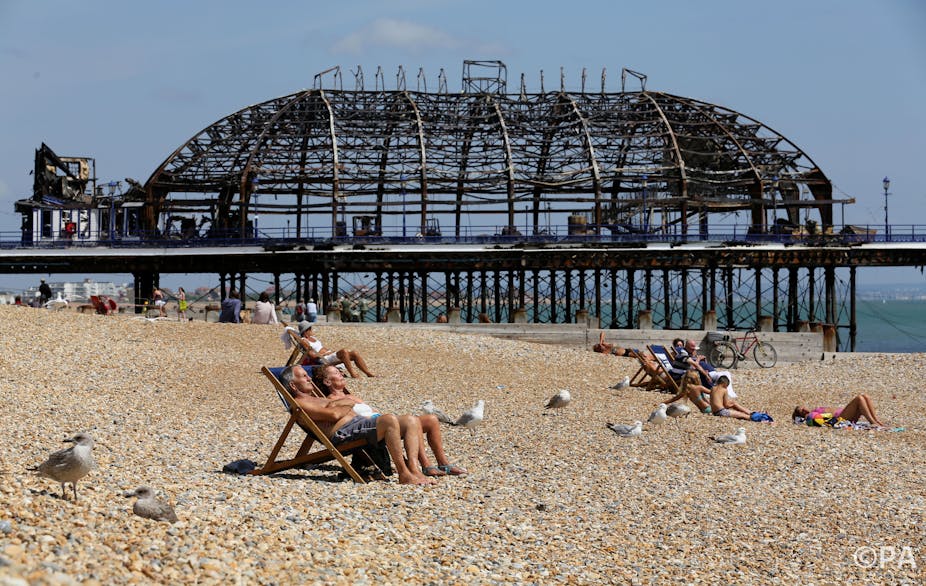The Eastbourne Pier fire reveals much about our enduring love of the seaside. As we bemoan the loss of a symbol of coastal fun and pleasure, the disaster and recent suspicions of arson also hint at the tense relationship between society and nature beside the sea, and how the veneer of pleasurable fun sometimes hides fear and violence.
The seaside holiday is a great unacknowledged British invention. It was accompanied by the creation of a new architecture for coastal leisure and the seaside resort, with piers one of its chief products.
Walking on a pier was to be transported ever closer to raw, untamed nature. As such, it heightened both the admiration of nature and of human accomplishment. It was also thought that the beneficial qualities of the sea air were heightened by proximity. There were new panoramas of the coast to view, storms and sunsets to marvel at and horizons to contemplate. The pier allowed people to reflect on themselves, other places and other times as they looked out at the horizon. At its beginnings, it was remarkable in seeming to enable people to journey a little closer to the unobtainable.

In older coastal towns that were being transformed into resorts, stone breakwaters and piers designed for maritime purposes were adapted for parading by fashionable visitors. Jane Austen was one of the first to contribute to the rich literary (and later filmic) tradition of using piers as sites of leisure and happiness but also unforeseen danger or denouement. She makes use of the Lyme Regis’s Cobb, an ancient stone pier, for a critical turning point in her novel Persuasion. One of the main characters, Louisa Musgrove, jumps down “from the high part of the new Cobb”, misses the safe hands of Captain Wentworth, to fall and be “taken up lifeless”.
In many early resorts, seaside entrepreneurs realised they could charge visitors for their promenade on what were originally designed as landing stage piers. One of these piers, Ryde, on the Isle of Wight, celebrates its bicentenary in 2014 and is recognised by pier aficionados as the first proper seaside resort pier.
By 1850 there were just a dozen piers in British resorts, most serving both as landing stages and promenades. By 1900 Britain’s seaside architecture had been transformed. There were now 80 piers in total: some resorts had two or even three of them. This new wave of piers were mostly designed simply for tourism. Eastbourne pier began its life in this way 1870. These largely open-decked piers became fashionable and select extensions to seafront parades and drives. Except the band providing music for the walkers, promenade piers had little in the way of artificial entertainment at the beginning.

The pleasure pier
As new middle class and, increasingly, working class seaside visitors flocked to the quickly growing resorts, the promenade pier gave way to the pleasure pier. Either newly constructed or transformed from earlier promenade structures – Eastbourne followed the latter course – the pleasure piers became sites of entertainment and amusement. Piers burgeoned with pavilions and theatres, concert halls and winter gardens, refreshment rooms and shops. Most pleasure piers also hosted a plethora of maritime entertainment ranging from steamer excursions to though aquatic entertainers and performing divers.
It was the combination of distinctive and at best magical pier architecture, maritime pleasures and indoor entertainment over the sea that made piers such an important feature of the British seaside experience from the late 19th to mid-20th century.
The challenge of pleasure pier building was to combine civil engineering for the extreme and inhospitable coastal margin with architecture designed to attract and entertain visitors.
New technology revolutionised pier construction. Cast and wrought iron was critical in the construction of pier substructures. The prefabrication of materials, including cast iron columns, and later steel frames, allowed the rapid construction of tall and wide load-bearing structures carrying wide promenades and large buildings on their decks. The Eastboune fire has laid bare pier construction techniques.

In the most successful resorts, piers were repeatedly extended and enlarged as the composition and demands of seaside visitors changed. Existing pier buildings were put to new uses. What was originally designed as a winter garden for musical entertainments might become a rifle range or roller skating rink, and then be transformed into an amusement arcade. Each transition might also involve an architectural and interior design make over. Ornate Victorian decoration might be hidden away behind a 1930s modernist facade.
There were difficulties ahead. Between the two world wars many piers began to struggle to meet the demands of the Britain’s new love affair with the sun. Architectural critics, too, bemoaned shoddy Victorian seaside buildings, old-fashioned cast-iron decoration and the absence of architectural purity.
One major response was to transform piers into platforms carrying funfairs and amusement arcades. Graham Greene’s 1938 novel Brighton Rock, and the later films reveal the resort’s Palace Pier as a site of fun and fear. And these same themes have been repeatedly exploited by novelists and film makers over the years. They, perhaps will last longer than the seaside piers, many of which have declined, closed or been destroyed through demolition, storm or fire, accidentally started or acts of arson. Pier fictions at times become realities.
But Eastbourne pier is unlikely to be part of that pattern. On Friday it was announced that Eastbourne is set to get a £2m boost as part of the government’s investment in the UK coast. But expect another pier to be lost before too long. Ultimately society struggles to keep nature at bay.

